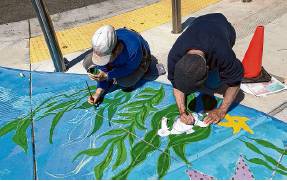Redefining retirement with unique co-housing communities
By Christine Delsol
Rising from the eastern bank of the Oakland Estuary at the foot of Park Street Bridge, the concrete, wood and glass face of Phoenix Commons in Oakland’s Jingletown looks like many industrial-chic buildings prominent in urban neighborhoods.
Phoenix Commons, though, is not a typical modern apartment or condo building. It’s a co-housing community for people 55 years and older who own private units but can choose to mingle in ground-floor common areas and attend communal dinners and other activities. The 41 living units occupy the second through fourth floors.
While the age range might suggest assisted living or skilled nursing homes, Phoenix Commons and its brethren more closely resemble a co-op with residents sharing management duties. The legal and financial structures, though, are usually based on homeowners or condominium associations.
“It’s not what many people imagine,” said Jyoti Rae, a former social worker from Indiana who followed her grown children to the Bay Area and moved into Phoenix Commons in 2016.
Rather than sitting around hoping for a phone call from family, residents are more likely preparing a communal dinner, chauffeuring grandchildren, setting up an event like the recent staged reading of “Our Town” or bicycling across the bridge. If you’re looking for JoAnna Allen, she might be paddling her pride and joy, an Oru Kayak, in the estuary.
“We are a very busy and active group,” Rae said.
Residents manage every aspect of running the community. They commit to volunteering on one or more of 17 teams, which includes dining, finance, gardening, social events and wellness, among many others. When not managing tasks, residents can join book and writing clubs and knitting, meditation and mahjong groups or pursue their own favorite activities.
“This is not the place to think about if you want to slow down,” Rae said.
Paths to cohousing
Within the population of about 50 Phoenix residents, many, like Rae, came to be near family. The security of living among people seems to appear on everyone’s list of benefits.
Allen made her way to Phoenix Commons with a history of working with disabled adults, membership in community supported agriculture, Peace Corps service, a “live simply that others may simply live” philosophy and children who settled in the Bay Area before she retired from teaching in 2007. She is devoted to cooking, kayaking and teaches a meditation course for prisoners.
For freelance medical journalist Larry Beresford, his wife’s retirement provided the impetus to downsize from their Oakland home and move in to the newly constructed Phoenix Commons, which opened in 2016. His profession and understanding of the beneficial impact of social connection on physical and mental health as people age bolster his planning of wellness education events.
“Growing old presents a lot of challenges, and dying is messy,” he said. “The community is not going to solve all those problems, but we can do a lot.”
Nancy Weavers, whose husband died recently, still runs a business selling specialized instruments to tech companies, but she’s contemplating retirement. While she enjoys having shops and coffee houses within walking distance, she said she most enjoys chatting with people while volunteering in the front office.
“People are very careful about being nosy,” she said. “They will leave you alone if you want them to.”
Carole White, who previously lived in multigenerational cohousing in Maryland, followed her children to the East Bay, consciously seeking “the old-fashioned village of the future.” She serves on three governing teams and is active in the book club and knitting group, but she also treasures her privacy. Echoing Weavers’ assessment, she adds, “A lot of us close our shades to indicate we want to be alone, and people respect that.”
For Jonathan Leavy and Angela Hunkler, settling in a supportive community before aging becomes a challenge was important. Leavy, a hospice chaplain with a background in musical theater, arrived in 2018 when his house in the Oakland hills began feeling too big.
“My husband, Paul, retired recently, and I just turned 60. I thought, ‘isn’t it wonderful that we don’t have to think about moving?’ In my work, I drive around to visit the sick and I see a lot of ways people are living,” Leavy said. “I come back here and I feel so grateful.”
Hunkler and her wife, Kate Murphy, cared for Murphy’s mom until she could no longer manage their stairs. Arranging for assisted living got them thinking, “that will soon be us,” and they started searching for cohousing. They chose Phoenix Commons for the care and attention residents give one another.
» “I was sold on the idea almost immediately. We humans are social animals, and living in isolation is not good for us.”
PatZy Boomer, resident at Mountain View Cohousing
“For me, it’s a better balance here, and I think I’m healthier,” Hunkler said.
Catching up with Europe
Cohousing originated in Denmark in the 1960s as a quest for more supportive living environments. Now well-established in Denmark and popular throughout Europe, the concept is still relatively rare in the United States.
It gained traction here with the 1988 publication of “Cohousing: A Contemporary Approach to Housing Ourselves” by architects Charles Durrett and Kathryn McCamant after extensive research in Denmark. Durrett published “The Senior Cohousing Handbook: A Community Approach to Independent Living” in 2005 (updated in 2009).
The Cohousing Company, Durrett’s Nevada City-based architectural firm, has designed buildings for more than 50 communities across the U.S. and beyond, including Muir Commons in Davis, North America’s first newly constructed cohousing community, in 1991. Thirteen of the communities are in Northern California with six in the greater Bay Area; San Francisco is notably absent because of its cost of building and difficult permit process. Still a passionate cohousing advocate, Durrett has loaded his website with a wealth of information.
Cohousing now claims several hundred communities throughout the country, though just a little over 30 are specifically for older adults, according to the Cohousing Association of the United States. (Exact numbers are elusive because organizations depend on individual communities to provide listings.) In the Bay Area, only Phoenix Commons — whose architectural team Durrett trained in cohousing concepts — can make that claim.
De facto older adult cohousing
To Raines Cohen, a specific focus on older adults is becoming a moot point since a community’s population naturally skews older as time passes. Cohen trained with Durrett and is a regional organizer for Cohousing California, a cohousing coach for East Bay Cohousing and a Certified Green Building Professional.
Berkeley Cohousing, where Cohen has lived since 2003, began with young families and single moms; Cohen was in the second wave.
“As kids have grown and moved out, people have stayed and grown older, so aging becomes very much a focus,” he said. “Now we’re getting a permanent wheelchair lift.”
Another example: Mountain View Cohousing is not age-restricted but currently consists of older residents, most but not all retired. Launched by a group of friends who had camped together every summer for decades, the 19-home project was designed by Durrett to support aging with such features as primarily single-story homes and an elevator and automatic door openers in the common house.
“I was sold on the idea almost immediately. We humans are social animals, and living in isolation is not good for us,” said PatZy Boomer, who saw her mother’s physical and mental health deteriorate when she stopped driving.
In her old neighborhood of 20 years, she didn’t know her neighbors well enough to ask them for help, and her kids lived too far away, so it was an easy decision. She moved in early 2015.
“Here we help each other with things people have trouble doing on their own and lots more,” Boomer said. “Just having people around to talk to is a huge support once people get more home-bound.”
Before taking the leap
Cohousing facilitates aging in community for older adults whose houses have become too large or lives have become too lonely. But going into it with eyes wide open is crucial. Cohousing organizations and individual communities let you know how to become a member of the community and what to expect by providing information through websites, open houses and meet-ups.
First, know that cohousing requires sharing core values, which Raines Cohen places under the umbrella of intention.
“You’re coming together to be good neighbors and create a community where you can live well together and, over time, age well together,” he said.
Or, as Leavy puts it, “You have to be prepared to live in relationship with other human beings.”
Communities encompass a broad range of personalities, which can get tricky — even bumpy — at times. Beresford maintains that they’ve been able to solve the important issues, though, and Weavers said a bit of bumpy road isn’t necessarily a bad thing.
“It leads to building community,” she said.
Management by consensus requires integrity and honesty, and it takes a certain kind of person to resist seeking power. It also can be time-consuming, and everyone has to contribute through a specific time commitment. White, who said her previous community in Maryland spent far less time on governance than Phoenix Commons does, jokes that “cohousing” means “lots of meetings” in Danish.
Finally, understand that cohousing cannot provide end-of-life care. On the spectrum from independent living to assisted living, it falls in the middle at interdependent living. Communities are looking for ways to increase the level of care available; Beresford’s wellness education and Berkeley Cohousing’s geriatric care manager — a volunteer who lives there — are part of that effort.
“We can’t provide the care a skilled nursing facility can,” Rae said. “But maybe we can find ways to keep them here longer.”




